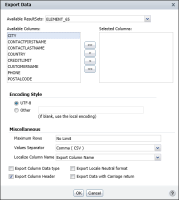How to export data in comma‑separated values file (.csv) format
1 From the main menu, as shown in
Figure 4‑1, choose Export Data.
Figure 4‑1 Exporting report data
2 On Export Data, Available ResultSets lists the report elements, such as tables, charts, cross tabs, Flash charts and gadgets, and so on, that contain data. Select an element from which to export data. The names on the list are internal names. For example, a report table element begins with the prefix ELEMENT, and is listed as ELEMENT_50, ELEMENT_65, and so on.
3 Available Columns lists the columns you can export from the specified table. You can export any of the data the report uses, including the data in aggregate rows and calculated columns. In Available Columns, select the columns to export one by one and choose the single right arrow after each selection, as shown in
Figure 4‑2. To select all columns, choose the double right arrow.
To deselect a column, choose a column from Selected Columns, then choose the single left arrow. To deselect all the selected columns, choose the double left arrow.
Figure 4‑2 Exporting report data
4 In Encoding Style, select UTF-8, or specify a style in Other. If you do not specify a style, Actuate BIRT Viewer uses the local encoding style.
5 In Miscellaneous, specify the following information:

In Maximum Rows, type the maximum number of data rows to export. To export all the data rows in the report, accept the default value of No Limit.

In Values Separator, choose the Comma (CSV) delimiter.

In Localize Column Name, select an option from the following:

Select Export Column Name to export the column name specified in the data source.

Select Export Column Display Name to export the column name specified in the report design.

Select Export Column Name and Display Name to export the column names specified in the data source as well as the one specified in the report design.
6 You can select the following additional options to export column data type, export the data in locale neutral format, and export the column header.

When you export report data to a flat file format, such as comma‑separated values (.csv) format, tab‑separated values (.tsv) format, pipe‑separated values (.psv) format, or semicolon-separated values format, select Export Column Data Type to include the data type information in the flat file. In the following example, the second line identifies the type of data in the file:
FirstName, LastName, AccountID
STRING, STRING, INT
"Doe", Jane", 1234 …

When you export report data that contains date‑and‑time values, the Actuate BIRT Viewers format these values according to the syntax in the current locale, by default. If no locale is configured, then the viewers use the US locale as the default. For example, if you export the date 01/10/2009 in the original format, it can be interpreted as January 10, 2009 or October 1, 2009, depending on whether the locale is US or France. On Export Data, select Export Locale Neutral Format to export report data without considering locale information, so that the date is interpreted correctly in every locale.

When you select Export Column Header, Actuate BIRT Viewer exports the column header in addition to the data in the column. The spreadsheet displays each exported column below the corresponding column header.

When you select Export Data With Carriage Return, the BIRT Viewers export the data using a Carriage Return (CR) character for each line break.
Choose OK.
7 On File Download, the default name and the file extension of the spreadsheet file appear.
Choose Save.
8 On Save As, complete the following tasks:
1 In Save in, navigate to the folder in which you want to save the file.
2 In File name, change the name of the file. Choose Save. The comma‑separated values (.csv) file appears in the new location.
When you open the file, the output data appears as an editable Microsoft Excel worksheet. You can expand the columns to view all the data.
Use the same process to export data to pipe‑separated values (.psv) files, tab‑separated values (.tsv) files, and semicolon-separated values (.ssv) files.


